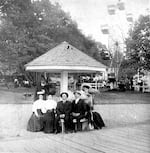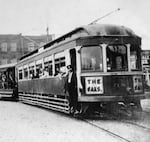On May 30, 1905, Oaks Amusement Park in Portland opened to the public.
Today, it is one of the oldest continually operating amusement parks in the United States and the only remaining trolley park on the West Coast.

This postcard, circa 1905, shows an early view of visitors to Oaks Amusement Park in Portland, Oregon.
Courtesy of Oaks Park
Oaks Park and the Expo
In 1905, Oregon Water Power and Railway Company opened Oaks Park Amusement Park — known as “The Oaks” — to boost ridership on its interurban streetcar lines. The timing could not have been better.
Just two days after the park’s grand opening, the Lewis and Clark Centennial Exposition also kicked off its temporary exhibit. From June through October, the Expo drew over a million paying visitors.
With streetcars ferrying riders across the city, many people ended up visiting both attractions over the summer of 1905.
In that first season, Oaks Park attracted 300,000 visitors with carnival rides, animal exhibits, dancing to live bands and nightly fireworks — not to mention all the light bulbs.
At a time when many homes still relied on gas or oil lamps, the use of electric lighting throughout the park proved to be an exciting attraction.

In this photo, circa 1905, a group of visitors enjoy a day at "The Oaks" amusement park.
Courtesy of the Oregon Historical Society
Streetcars and trolley parks
At the turn of the 20th century, hundreds of trolley parks operated across the country. Electric rail companies built the parks to attract riders on weekends and off-hours.

This image, circa 1905, shows an electric trolley car taking passengers to "The Oaks" amusement park.
Courtesy of the Oregon Historical Society
Before most people owned automobiles, streetcars — often called trolleys — provided affordable public transportation.
Oregon had one of the most extensive streetcar systems in the country, with interurban electric rail connecting Portland to surrounding towns like Gresham, Estacada and Oregon City. Some lines ran down the Willamette Valley, extending all the way to Eugene.
Streetcar neighborhoods are born

This image, circa 1905, shows an interurban electric line train going to "The Oaks" amusement park.
Courtesy of the Oregon Historical Society
Many streetcar lines were operated by real estate and electrical companies.
The business model involved developing tracts of land outside city centers, with electric streetcars transporting riders between work in the city and home in the newly developed suburbs.
To maximize profits, the company also built attractions, such as trolley parks, at the end of their lines.
It gave riders another reason to buy a ticket and take the trolley in the evenings and weekends when the commuter trains were otherwise empty.
Oaks Park — one of the last
Over the years, Portland was home to at least three other amusement parks, including one located atop Council Crest that operated from 1907 to 1929.

This undated advertisement shows off Council Crest amusement park.
Courtesy of the Oregon Historical Society
Lotus Isle only lasted a couple of years in the 1930s, but even in that short time, it still managed to have the most disturbing history of all the city amusement parks (we’ll save those stories for another day).
Jantzen Beach remained a popular attraction until it closed in 1970. Reportedly, it was the largest park of its kind in the country when it opened in 1928.
Only “The Oaks” still welcomes visitors, though it is no longer accessible by streetcar.
Today, the park operates seasonally as a nonprofit through the Oaks Park Association.

